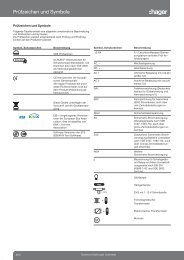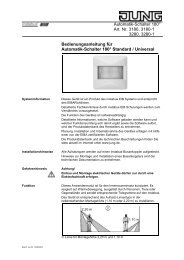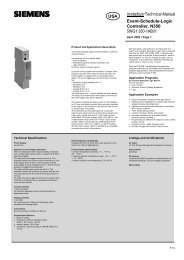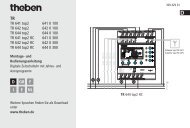Create successful ePaper yourself
Turn your PDF publications into a flip-book with our unique Google optimized e-Paper software.
A distinction is made between the following system statuses...<br />
- "Unarmed" status:<br />
If both security areas are unarmed, break-in messages in these areas<br />
(e.g. a window is opened), or a a sabotage messages do not lead to an alarm. Active detectors<br />
are then only displayed in the detector list. The system can only be armed from the<br />
"Unarmed" status, when the appropriate security areas are ready for arming. The status<br />
display of a security area on the panel system page of the signalling system displayed<br />
"ready" when detectors in the appropriate area are inactive. If detectors are active, then the<br />
status displays "not ready".<br />
In the "Unarmed" status, sabotage signals (active sabotage input) will lead to a fault, which<br />
is signalled via the appropriate communication object or directly on the panel on the system<br />
page of the signalling system (cf. "Fault" status). The "Unarmed" status can be signalled<br />
using the "Arming message, internal" or "Arming message, external" and "Unarming acknowledgement"<br />
objects on the bus.<br />
- "Armed" status:<br />
A security area can only be armed when all the detectors assigned to this area are inactive<br />
and there is no fault. I this case, the status "Ready" is displayed on the system page of the<br />
signalling system.<br />
In addition, this status can be signalled on the bus for each security area using the "Ready<br />
to arm ..." status ("0" = Not ready to arm / "1" = Ready to arm).<br />
If security areas are armed, break-in messages in these areas will trigger an alarm. A distinction<br />
is made between...<br />
"Internally armed": only the external skin of a building is monitored. Authorised people are<br />
located in the interior of the building. No alarm is triggered for as long as the external skin<br />
is 'infringed'. Motion detectors installed in the interior detect movements but no alarm is<br />
triggered. A sabotage signal will immediately trigger alarm in the "internally armed" status.<br />
"Externally armed": all the internal and external detectors, i.e. both security areas, are monitored.<br />
An alarm is triggered when any detector responds (also the sabotage detector).<br />
Should an area not be ready for arming, the panel displays "Not ready" on the signalling<br />
system page and the value of the "Ready to arm" object is "0". Before arming in this case,<br />
the cause (e.g. an open window) must be detected and eliminated. The detector list can<br />
help here, as it displays all the active detectors.<br />
It is possible to configure an arming delay time in the ETS plug-in for both internal and external<br />
arming. For example, the delay time is necessary when a switching unit<br />
(e.g. keyswitch) is located within an areas to be monitored and the area is evacuated before<br />
arming. The same applies when the system is armed externally from the panel. The<br />
delay time specifies after what time after a arming command (turning of the keyswitch or<br />
pressing of the "Arm" button on the panel) the system is actually armed. On setting the<br />
time, some extra time should be planned for, in order to allow the system operator to leave<br />
the building to be armed correctly, before actual arming. Only when the delay time has<br />
elapsed should there me no detectors active, as otherwise arming will not take place.<br />
Order-No. 7574 00 1X<br />
Software "...590101"<br />
Functional description<br />
Page 113 of 222

















